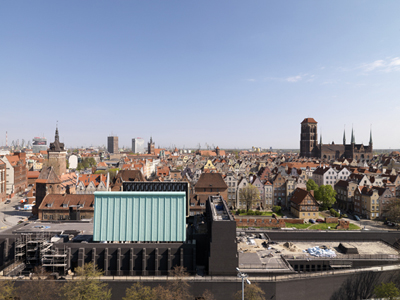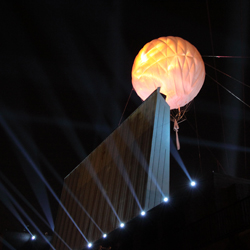You are in: Home page > Magazine Archive > Gdansk Shakespearian Theatre
Abstract
On 23 April, the date of the birth and death of William Shakespeare, the openable roof of the new Elizabethan Theatre in Gdańsk was inaugurated, with an official ceremony for the latter to come in September.
The event became an opportunity to celebrate both the plastic powers of the symbol, which, scattered through the metaphysics of places (and memory), guide the forces to 'form' as well as the values and ideals that have sustained the tormented historical process of this Baltic city and the Polish nation as a whole.
William Shakespeare (1564-1616) was born and died on the same day: 23 April. That date now becomes the occasion for another dual event. Commemorating this English genius and inaugurating the wings of the openable roof of the new theatre in Gdańsk dedicated to him, which will be completed by next September. An event that is 'symbolic' and concrete at the same time. That evening, a crowd of more than three thousand people thronged the grandstands specially built close to the historical city walls, in front of the long dark outline of the new building. The walls of black brick, made even more evanescent by the dark, as if by magic looked like an immense curtain opening onto the audience's imagination. In fact, things had swapped their habitual roles. The theatre building was the real actor. The spectators were awaiting its 'performance'. However, the event's programme depended on another factor. The weather. The general feeling was, however, of attending the celebration of a ritual. And since every ritual has its own liturgy, in our case, the offer replaced the sacrifice. The ceremony began with a masked tribute. This was the offer to the 'star'. A long procession wended onto the terraces like the ghost in Hamlet's mind. Those dancing shapes were driven by the wind. It blew from the north, chill, at more than twenty knots. Persistent, it even dulled the hopes entrusted to the script. The surprise, in fact, was supposed to come from a large sphere with a 12m diameter. Hidden in the bowels of the theatre it was supposed to protrude above the wings, when they were open, like a magnificent rising moon. An emblem of a new world already here and another on the point of arriving. But those boreal winds blew in another direction. Only the wings opened. For safety reasons, it was not possible to raise the sphere. The weather had decided otherwise. The desire was to restore to the 'theatre', through its solitary winged gesture, the 'sacred' dimension of Gdańsk, of Poland itself.
However, we must immediately clarify the use of the terms 'sacred' and 'symbolic'. The openable roof certainly has a typological motivation that belongs to the history of 17th century Elizabethan Theatre. The buildings, like the Globe, were predominantly open courtyards lit by natural light. And if this is indisputable from a historical point of view, it cannot be from a symbolic one. Modern technique, with its endless constructive possibilities, is totally indifferent to sense (the ideal) and completely restricted to meaning (the concrete). While the 'symbol', due to its meta-linguistic properties, is fully restricted to sense and freely devoid of meaning. The plastic powers of the symbol are sown among the metaphysics of places (and memory) and guide all forces to the 'form'. And to exit from the abstraction of reasoning, we can say that metaphysical 'places', always immanent or incorporated in physical places, are nothing more than a densification of the values and ideals decanted along the tormented historical process of this Baltic city and the Polish nation as a whole. The problem to solve, then, was not the practical realization of a openable roof. A solution using sliding panels, for example, was unquestionably cheaper to finance and easier to construct. Instead, it depended on that sense of 'ritual' that it was desired to infuse the movement of the 'opening' with. Opening the wings of a roof as if they were two wings hinged on the main walls, which would rise above the building to double its height, was going to have repercussions on the theatre's entire formal setting. The larger loads were not given by the static nature of the materials, but by the dynamics of the stresses acting at the top. Indeed, above the roof. The wings, behaving like two gigantic sails under the action of the wind, were going to multiply the stresses that were then to be discharged through the foundations. Like having a dam on the roof. By now, it was clear. This type of 'opening' was definitively going to influence the building's overall 'character'. The rhythm of the vertical ribs, the horizontal masonry ring, the anchorage to the ground, everything was necessary to give force to the inner column of vertical light, which by depriving the functional artifice of the construction, dematerialized it, transforming the theatre into an external court, but above all into a vortex for the imagination (doubly functional). And it is precisely from here that is regenerated the powerful breath of history and consciousness of the Polish people. From that cavity gush forth the gusts of Nordic wind. The howl of Oscar Matzreath that shattered the glass of the windows, (the main character in the novel "The Tin Drum" by the Gdańsk writer Gunter Grass, 1999 Nobel Prize Winner for Literature) anticipating by twenty years, the screams of the Lenin shipyard workers in Gdańsk. Those cries are repeated like an incessant echo against all abuse of power and violence as social conventions. Then as Now. They were so strong that that, in 1989, they would crush the entire 'Iron Curtain' and completely transform the geopolitical boundaries of Central Europe. The leader of Solidarność, Lech Wałęsa, with the not-so-underground aid of Pope Karol Wojtyla, was to receive the 1983 Nobel Peace Prize, precisely because of his steely determination. So how could the construction of the new theatre in Gdańsk ignore these ideal, metaphysical powers, of the Polish spirit? How could it ignore the teaching and work of another great man, the film director, Jerzy Grotowski, who thought of theatre as a 'ritual ceremony', as the 'sanctity of theatrical space'?
So here is where the 'symbol' and the 'sacred' come together. Not in a futile definition, but in a feasible representation. In a real building. The opening movement of the wings, these metal arms that extend upwards towards the sky (another similarity with the films 'Man of Marble' and 'Man of Iron' by Andrzej Wajda, an Oscar winner for his career in 2000; works dedicated to the trade union movement of Gdańsk) are nothing more than a gesture of thanks, of gratitude to the Polish spirit and those ideals that should still unite us today. The theatre, with the 'ritual ceremony' of the opening of the wings, renews and perpetuates (this at least is the desire) the liturgy of devotion: to the city of Gdańsk, and the sufferings of a people that are the basis of values and our human dignity.
















